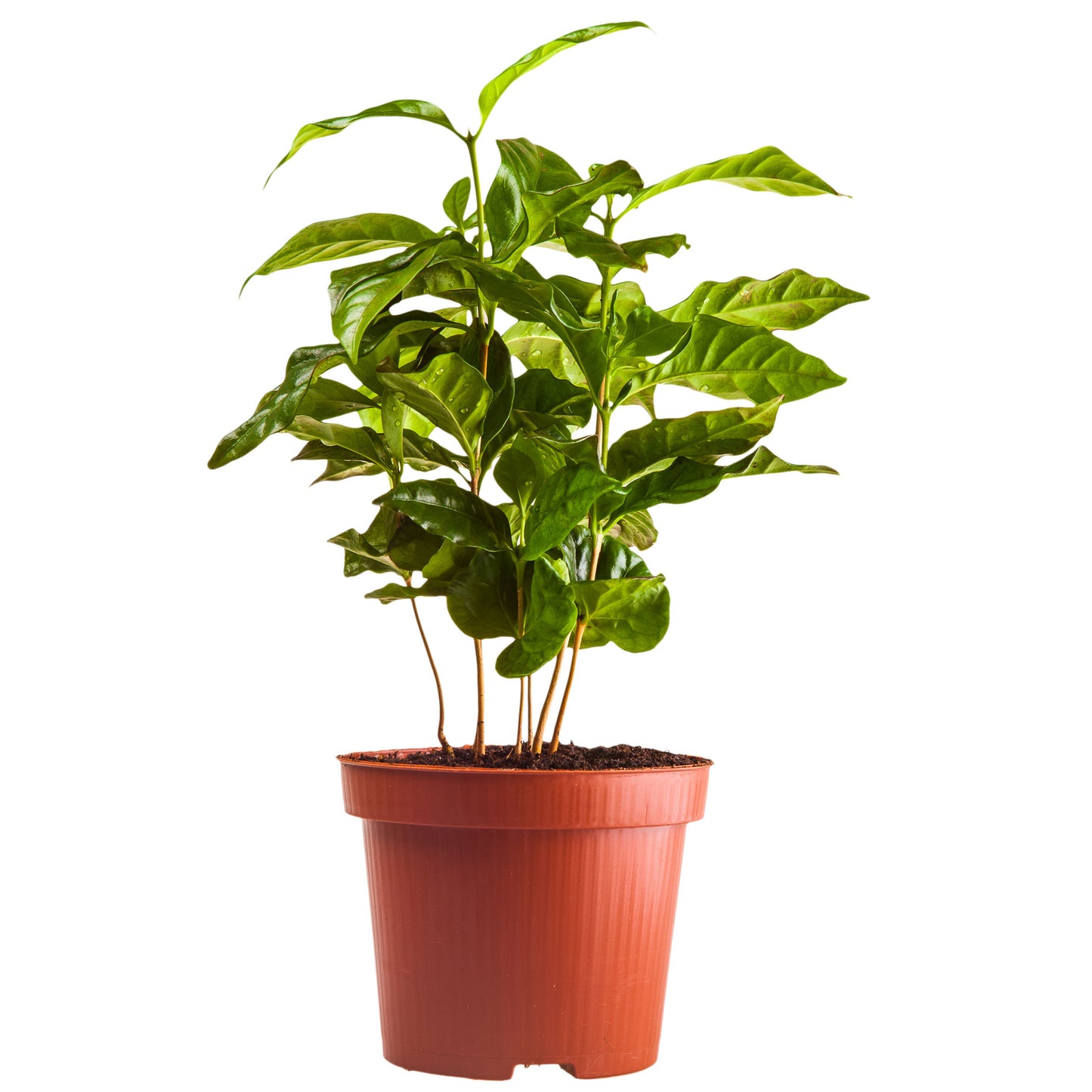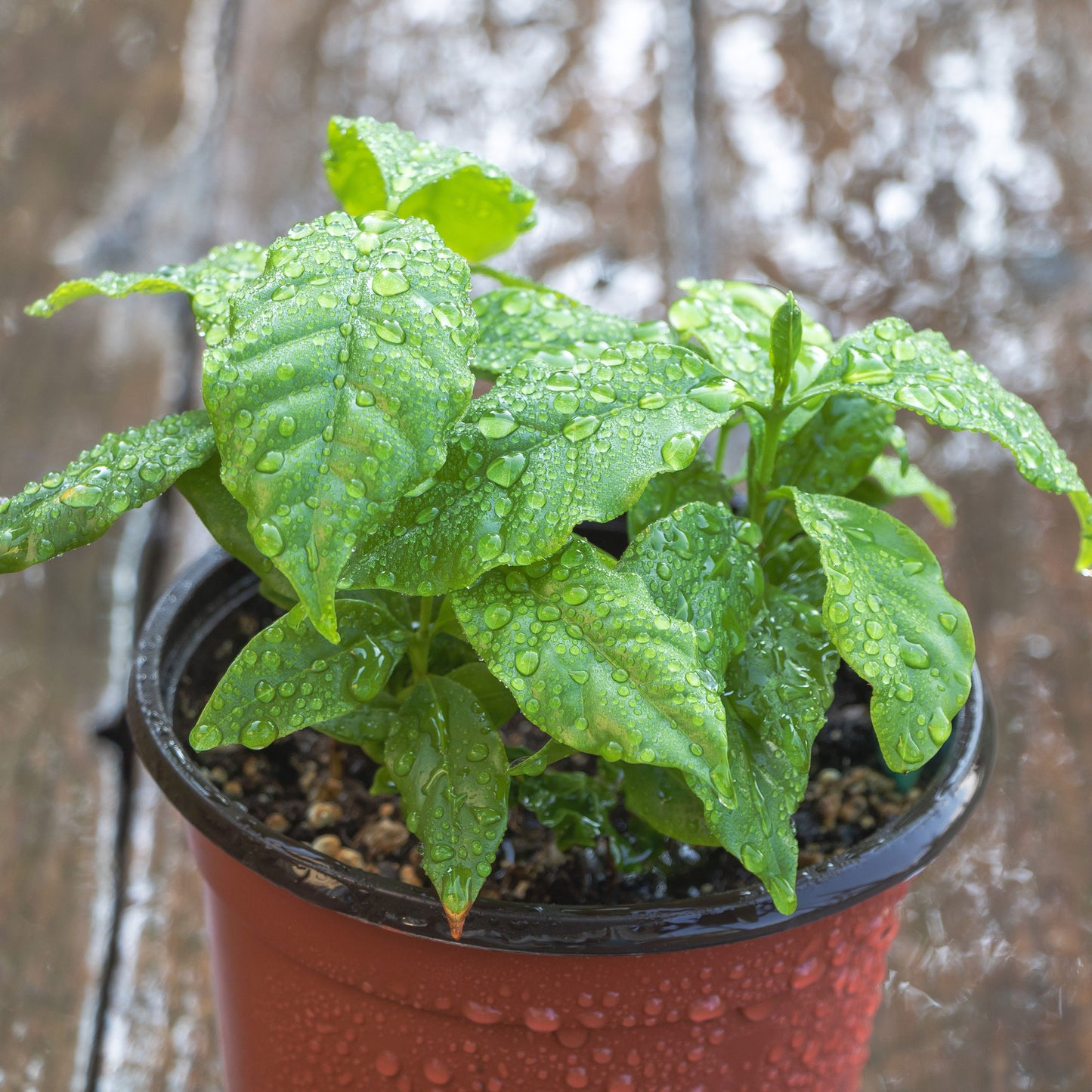Arabica Coffee Plant
Arabica Coffee Plant
SKU:EDB-COF-ARA-NA-3G
Wake Up Your Garden with the Arabica Coffee Plant!
Ever dreamt of growing your own coffee? Now's your chance! The Arabica Coffee Plant isn't just a source of your morning brew; it's a lush, glossy addition to your home or garden. With deep green leaves and the promise of actual coffee beans, it's a plant that truly rewards your care.
Why You'll Love the Arabica Coffee Plant:
- Homegrown Goodness: Imagine sipping a cup of coffee made from beans you've grown yourself. It's freshness you can't buy at the store!
- Stylish and Versatile: This plant fits perfectly in modern, rustic, or any decor style in between. It's a versatile beauty that enhances any space.
- Easy to Care For: With basic care, the Arabica Coffee Plant thrives, making it a great choice for both green thumbs and beginners.
- Year-Round Interest: Enjoy the evergreen foliage all year, and with proper care, you'll see white, jasmine-scented flowers that develop into coffee beans!
Planting & Care Tips:
Place your Arabica Coffee Plant in a spot with bright, indirect light and keep the soil consistently moist, but not waterlogged. With a little patience and love, you'll be well on your way to harvesting your own coffee beans. Talk about a 'perk'!
Ready to add a jolt of excitement to your plant collection? Order your Arabica Coffee Plant today and turn your home into the coffee haven you've always wanted!




Product Details
-
Product Category
Edibles
-
Product Subcategory:
Coffee Plants
-
Botanical Name:
Coffea arabica
-
Does Not Ship To:
AZ, OR
-
Mature Height:
6 ft.
-
Mature Width:
3 ft.
-
Growing Zone:
4-11 patio / 9-11 outdoors
-
Indoor Growing:
Indoors or Patio (non-freezing)
-
Sunlight:
Full-Part Sun
-
Growth Rate:
Moderate
-
Harvest Time:
September-October
-
Bloom Time:
Late Spring to Early Summer

Planting Directions
<h2>Planting Arabica Coffee Plant</h2>
<ul>
<li><strong>Choose a location:</strong> Select a spot with dappled or indirect light and protection from strong winds. Coffee plants prefer temperatures between 60-75°F (15-24°C).</li>
<li><strong>Soil preparation:</strong> Use well-draining and slightly acidic soil (pH 6-6.5). Amend with organic matter like peat moss or compost.</li>
<li><strong>Planting:</strong> Plant seeds or seedlings in a pot indoors or in the ground if the climate is suitable. Bury seeds 0.5 inches deep and water gently.</li>
<li><strong>Watering:</strong> Keep the soil consistently moist but not waterlogged. Reduce watering in the winter.</li>
</ul>
<h2>Care and Maintenance</h2>
<ul>
<li><strong>Fertilization:</strong> Feed with a balanced, slow-release fertilizer every two months during the growing season.</li>
<li><strong>Pruning:</strong> Prune to encourage bushiness and remove any dead or yellowing leaves.</li>
<li><strong>Pest control:</strong> Watch for common pests like aphids and spider mites. Use insecticidal soap or neem oil as a natural treatment.</li>
<li><strong>Repotting:</strong> Repot every couple of years to refresh the soil and accommodate growth.</li>
</ul>
<h2>Pollination</h2>
<p>Coffee plants are self-pollinating, but you can gently shake the branches to help distribute the pollen if you want to encourage fruit set indoors.</p>
<h2>Harvesting</h2>
<p>Harvest coffee cherries when they turn bright red, typically after several years of growth. Dry and remove the outer cherry to reveal the coffee beans inside.</p>
<p>Remember, patience is key with coffee plants. They take time to mature and produce fruit, but with consistent care, you'll be rewarded with your own coffee beans.</p>

FAQs
<h2>FAQs for the Growing Arabica Coffee Plants</h2>
<h3>1. How do I plant Arabica coffee seeds?</h3>
<p><strong>Step-by-Step Guide:</strong></p>
<ol>
<li><strong>Preparation:</strong> Start with fresh coffee seeds for the best germination rate. Soak the seeds in water for 24 hours to soften the outer shell.</li>
<li><strong>Soil:</strong> Use a well-draining soil mix, ideally with a pH between 6.0 and 6.5. A mix of peat, perlite, and vermiculite is recommended for good drainage and aeration.</li>
<li><strong>Sowing:</strong> Plant the seeds 1 inch deep in the soil. Make sure the flat side of the seed is facing down.</li>
<li><strong>Location:</strong> Keep the pot in a warm, shaded area. Avoid direct sunlight, which can scorch young plants. A temperature between 20°C to 25°C (68°F to 77°F) is ideal.</li>
<li><strong>Watering:</strong> Keep the soil consistently moist but not waterlogged. Use a spray bottle to mist the soil surface if it begins to dry out.</li>
</ol>
<h3>2. How do I care for my Arabica coffee plant?</h3>
<ul>
<li><strong>Light:</strong> Provide bright, indirect sunlight. If growing indoors, a south-facing window with a sheer curtain is ideal.</li>
<li><strong>Watering:</strong> Water when the top inch of soil feels dry to the touch. Reduce watering in the winter during the plant's dormant period.</li>
<li><strong>Fertilization:</strong> Feed with a balanced, water-soluble fertilizer every month during the growing season. Halve the recommended dose to avoid over-fertilization.</li>
<li><strong>Pruning:</strong> Prune in the late winter or early spring to maintain shape and encourage bushier growth. Remove any dead or diseased branches.</li>
<li><strong>Repotting:</strong> Repot every couple of years or when the plant becomes root-bound. Increase the pot size gradually.</li>
</ul>
<h3>3. When and how do I pollinate Arabica coffee plants?</h3>
<p><strong>Arabica coffee plants are self-pollinating</strong>, meaning they do not require external pollination from bees or other plants. However, gently shaking the plant to mimic wind or using a soft brush to transfer pollen from one flower to another can help increase fruit set in indoor conditions.</p>
<h3>4. What common problems should I look out for?</h3>
<ul>
<li><strong>Pests:</strong> Watch for common pests like spider mites, aphids, and mealybugs. Use insecticidal soap or neem oil as a natural remedy.</li>
<li><strong>Diseases:</strong> Root rot can occur in waterlogged soil. Ensure good drainage and avoid overwatering. Leaf rust and coffee berry disease are also concerns but less common in home environments.</li>
<li><strong>Environmental Stress:</strong> Browning leaf tips can indicate too much direct sunlight or fluoride in water. Use filtered water and protect from harsh sunlight.</li>
</ul>
<h3>5. When is the best time to harvest coffee cherries?</h3>
<p><strong>Harvesting:</strong> Arabica coffee cherries usually ripen about 7-9 months after flowering. Wait until cherries are a deep red color before harvesting. Gently twist the cherries off the branch. Remember, not all cherries will ripen at the same time, so you may need to harvest in stages.</p>
<p>By following these guidelines, you can successfully grow and care for your Arabica coffee plant. Remember, patience and attention to your plant's needs are key to cultivating a healthy and productive coffee plant. Happy gardening!</p>





